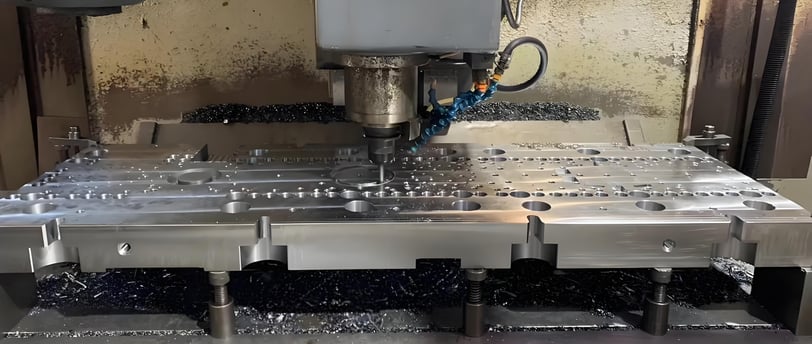Environmental Design and Energy Saving Technology for Stamping Dies
2/21/2025


Introduction to Stamping Dies and Their Environmental Impact
Stamping dies are essential tools utilized in manufacturing processes, particularly in the production of metal components. They serve to shape, cut, and form materials into specific designs and sizes, playing a critical role in the automotive, aerospace, and consumer goods industries, among others. The significance of stamping dies lies not only in their ability to enhance productivity but also in their influence on the overall efficiency of manufacturing operations.
However, the traditional use of stamping dies has raised concerns regarding their environmental impact. The manufacturing processes that utilize these dies typically incur high energy consumption, leading to increased operational costs and carbon emissions. Additionally, the waste produced during stamping operations—such as scrap metal and other by-products—adds to the environmental burden. These factors highlight the necessity for sustainable practices in the design and operation of stamping dies.
Responding to the mounting pressures of environmental responsibility and regulatory compliance, manufacturers are increasingly adopting integrated environmental design principles and innovative energy-saving technologies in their stamping operations. By focusing on eco-efficiency, companies can reduce waste generation during stamping processes while simultaneously optimizing energy use. This transition not only benefits the environment but also enhances the economic performance of manufacturing businesses.
The realization of these benefits depends on a comprehensive understanding of how traditional stamping dies function, as well as their potential for improvement through advanced technologies. In the following sections, we will delve deeper into the challenges posed by conventional stamping methods and explore strategies that leverage new technological advancements to mitigate these environmental impacts effectively.
Principles of Environmental Design in Stamping Dies
Environmental design principles are increasingly vital in developing stamping dies, as they emphasize sustainability and energy efficiency. The selection of sustainable materials is a critical aspect of this process. Using materials that are recyclable or have lower environmental impacts ensures that the final products contribute minimally to ecological degradation. For example, materials with reduced toxicity or those sourced from renewable resources can significantly lower the carbon footprint associated with the manufacturing phase of stamping dies.
Design optimization for energy efficiency is another key consideration in the environmental design of stamping dies. By implementing innovative design techniques, engineers can enhance the performance of dies while reducing energy consumption during the manufacturing process. Employing advanced simulation tools allows designers to model and analyze die designs, leading to improved structural integrity and heat distribution. This ensures that the stamping process operates effectively while using minimal energy, thereby contributing to overall energy efficiency.
Additionally, minimizing waste is an essential principle of environmental design in stamping dies. By employing design strategies such as material nesting and efficient part layouts, manufacturers can significantly reduce scrap material generated during production. Innovations in die construction, such as modular designs, also enable maintenance and adjustments with minimal material loss over time. This thoughtful approach ensures that resources are utilized effectively and helps address concerns related to the disposal of manufacturing byproducts.
A comprehensive lifecycle assessment (LCA) plays a crucial role in evaluating the environmental impact of stamping dies from production through to disposal. Through LCA, stakeholders can understand the resource consumption, emissions, and waste associated with each phase of a die's life. This awareness informs better design decisions that prioritize reducing negative environmental effects, thereby fostering a culture of sustainability and responsibility in the stamping industry.
Innovative Energy Saving Technologies for Stamping Dies
The manufacturing of stamping dies has seen a significant transformation due to the advent of innovative energy-saving technologies. These advancements play a crucial role in optimizing energy consumption while maintaining precision and efficiency in the production process. A notable advancement in this field is the deployment of automation systems, which streamline operations and reduce the overall energy footprint. By integrating automated machinery, manufacturers can achieve higher operational efficiency and minimize human error, resulting in both resource conservation and cost reduction.
Energy-efficient machinery is another key component in the drive towards sustainable stamping die manufacturing. Modern machines are designed with integrated systems that actively monitor energy usage and implement measures to lower consumption during idle times. Enhanced design features, such as variable-speed drives and improved insulation, also contribute to significant energy savings. These innovations not only support a reduction in operational costs but also align with broader environmental goals by lowering greenhouse gas emissions associated with production processes.
The integration of renewable energy sources marks a transformative step in making stamping die manufacturing more sustainable. Facilities are increasingly harnessing solar or wind power to assist in their energy needs, thus decreasing reliance on traditional energy sources. This shift not only impacts energy costs favorably but also promotes a greener manufacturing landscape. Furthermore, machine monitoring and predictive maintenance techniques have emerged as essential practices for enhancing energy efficiency. Through real-time data analysis, companies can identify inefficiencies and undertake timely interventions to reduce energy wastage, which significantly contributes to the optimization of the production lifecycle.
Overall, the adoption of these innovative technologies in the stamping die industry illustrates a commitment to sustainability and efficiency. By continually advancing equipment and procedures, manufacturers can effectively meet energy-saving objectives while enhancing productivity and ensuring a resilient operational framework.
Future Trends and Best Practices in Stamping Die Manufacturing
The future of stamping die manufacturing is poised to undergo significant transformation, primarily guided by the principles of environmental sustainability. As the industry evolves, a heightened emphasis on energy efficiency and reduced environmental impact will emerge. Central to this shift will be the adoption of circular economy principles, which advocate for the reusability, repairability, and recyclability of materials and components, thus minimizing waste and resource extraction.
Innovation in eco-design will play a critical role in shaping the future of stamping dies. Manufacturers are increasingly recognizing the importance of designing products that are not only high-performing but also sustainable throughout their lifecycle. This may involve selecting materials that are less harmful to the environment, implementing production processes that consume less energy, and integrating renewable energy sources into the manufacturing operations. By prioritizing eco-design, companies can enhance the longevity and efficiency of their stamping dies while aligning with global sustainability goals.
The influence of regulations on energy-efficient practices cannot be overlooked. Governments and international bodies are progressively establishing stricter environmental standards that compel manufacturers to reassess their production methodologies. Compliance with these regulations will necessitate investing in advanced technologies that facilitate lower energy consumption and emission reductions, thereby fostering a competitive edge in the market. As these regulations tighten, firms will be motivated to innovate in order to meet and exceed these standards.
To transition effectively toward environmentally friendly stamping die production, companies should adopt best practices such as conducting thorough lifecycle assessments to identify improvement areas, investing in training for employees on sustainable practices, and collaborating with suppliers who share the commitment to sustainability. By integrating these approaches, manufacturers can position themselves as leaders in the shift toward a more sustainable future in stamping die production.
